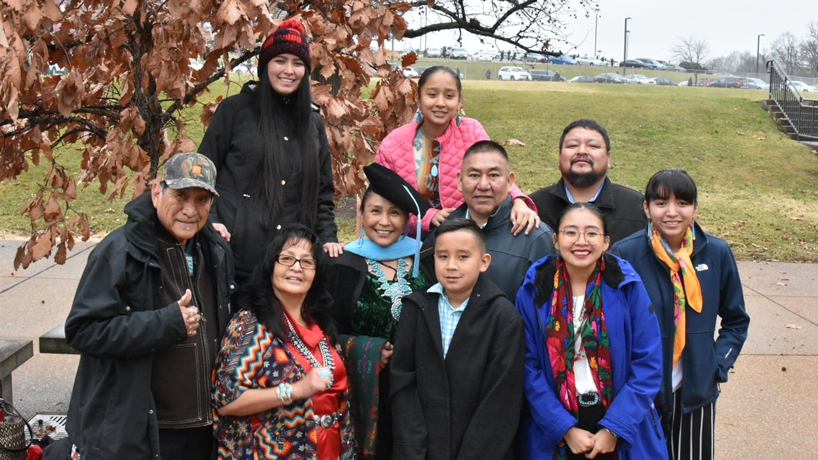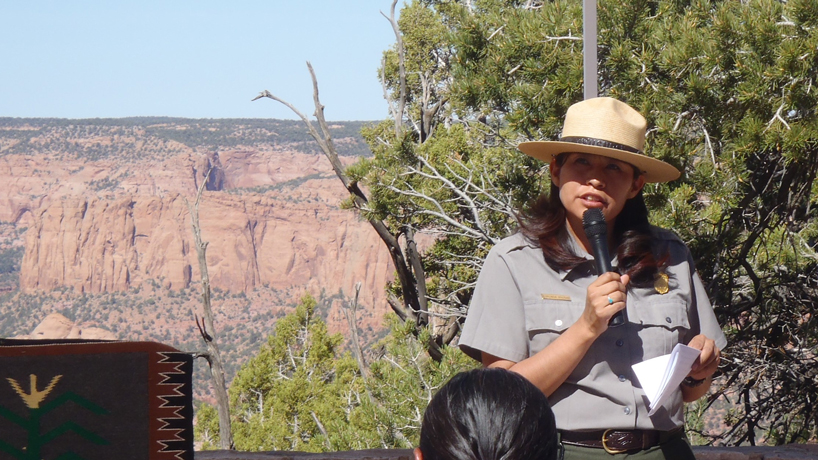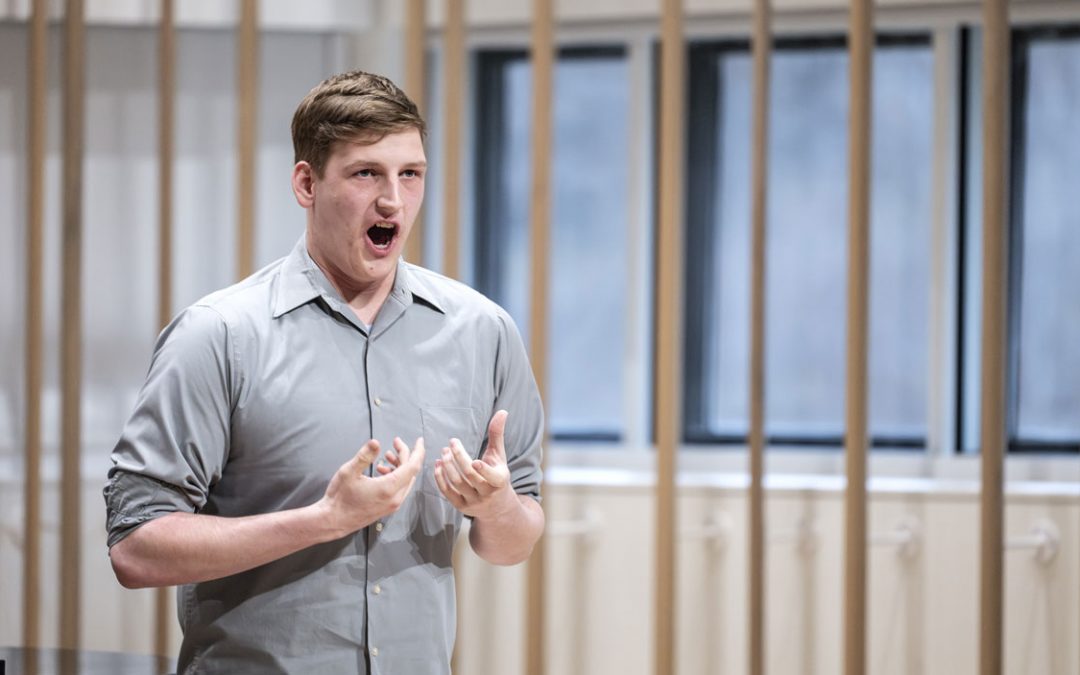
Curlinda Mitchell Blacksheep (center in tam and gown) traveled from Arizona to St. Louis with her family to attend fall commencement. Blacksheep graduated with an EdD, which will support her heritage leadership work at Navajo National Monument. (Photos courtesy of Curlinda Mitchell Blacksheep)
Curlinda Mitchell Blacksheep drove approximately 1,200 miles from Arizona to attend the Fall Commencement ceremony last month at the University of Missouri–St. Louis.
However, upon arriving in St. Louis the day before graduation, Blacksheep found that the UMSL Triton Store – where her tam and gown were being held – was closed. It was not an ideal end to a thousand-mile road trip.
“I was a little nervous that I wasn’t going to get it at the ceremony,” she said. “I emailed my professor and other classmates, and several people said they knew for sure I could pick it up at the ceremony. It made me feel a lot better.”
The next day, she walked across the stage – properly attired – to receive her doctorate in education. Blacksheep, a park ranger at Navajo National Monument and member of the Navajo Nation, was part of an innovative EdD cohort, Heritage Leadership for Sustainability, Social Justice and Participatory Culture, led by Theresa Coble, the E. Desmond Lee Endowed Professor of Experiential and Family Education.
The cohort differs from typical doctoral programs in that it’s designed to be completed in three years and operates almost entirely online. That digital approach made it possible for Blacksheep, who was unable to take a sabbatical from the National Parks Service or part from her family, to further her education.
“I had already been looking for a doctoral program for quite some time, almost 10 years,” she said. “I looked at other programs, a few that were from Arizona and from California, but they had requirements of staying on campus.”
The beginning of Blacksheep’s doctorate at UMSL started much like how it ended – in a rush. One day, she got an email from the National Park Service’s career development office advertising the EdD cohort. There was a problem, though.
“One thing that caught my eye was that the due date was a month prior,” Blacksheep said. “I was thinking, ‘Hey! I got this email today, but it’s got an expiration date for last month.’”
Undeterred, she called Coble who informed her that the date wasn’t concrete. There was still room in the cohort, but application materials needed to be sent ASAP. Blacksheep hurried to submit her application and waited on a decision.
Eventually, Coble called with the good news. Blacksheep was excited but also uncertain. She had been searching for an opportunity like this for 10 years, but her life had become busy.
“I was really excited and also, at the same time, anxious because I didn’t know what it would mean for me as far as working full time, being a mother of four and being in the middle of planning a wedding,” Blacksheep said. “There was so much happening.”
Once classes started, her worries subsided. She had experience with other online classes and found them impersonal, but that was not the case with the EdD cohort. Classes were conducted remotely with video, so classmates could put a name to a face and interact with each other.
“The online program made me feel like I was right in the classroom with them,” she recalled.
 Part of Curlinda Mitchell Blacksheep’s work at Navajo National Monument involves educating visitors about the park’s cultural and historical significance.
Part of Curlinda Mitchell Blacksheep’s work at Navajo National Monument involves educating visitors about the park’s cultural and historical significance.
Aside from the advantages of studying remotely, Blacksheep was drawn to the program’s focus on heritage leadership. Much of her work at Navajo National Monument revolves around the discipline, which involves fostering connections to important natural and cultural sites through education. The intent is to help preserve and protect these sites by encouraging greater understanding of their significance.
This reverence for culture and history is not just part of the job – it’s part of who Blacksheep is. She grew up immersed in oral storytelling in a Navajo – or as they refer to themselves, Diné – household. Diné was her first language, and she didn’t learn English until she started elementary school.
Now, Blacksheep translates Diné elders’ stories and communicates them to visitors at the Navajo National Monument. It’s an increasingly rare skill that allows her to continue their teachings in an accurate and respectful manner. She says it’s rewarding to carry on the legacy of her people with visitors.
“They get to share a piece of our culture, the language and the history of the local Native Americans who live here and have lived off of the land,” Blacksheep said.
In addition to cultural education, Blacksheep guides hikes through the wilderness in the park’s canyons and backtrails. For her, there’s no better place to teach.
“Although I have a background in education, I wasn’t too excited about being in a classroom,” she said. “I felt more comfortable with non-traditional education, outdoor education.”
While she would rather be outside now, Blacksheep can trace her passion for education back to a desk. At first, school was challenging as an English-as-a-second-language student. Diné is primarily an unwritten language, and learning a new alphabet – or even being given written materials at all – was a culture shock.
But she soon became enamored with reading and writing as she adjusted to the classroom.
“To me, it was like magic,” Blacksheep said. “People speaking English and reading English off of a book. I did not comprehend how that was all happening because Navajo, or Diné, language and communication is all oral.”
Blacksheep hopes she can spark the imagination of a new generation of students with heritage leadership. She’s currently putting her doctoral research into practice by collaborating on an initiative with local schools.
Indigenous culture is being weaved into K-12 curriculum via a raised garden project. Students grow plants native to the area from seeds in a school greenhouse. They also learn about the cultural uses of the plants, from food to medicine, in the classroom.
Once the plants reach maturity, they’re transferred to raised beds at Navajo National Monument. Other community groups such as the Girl Scouts are involved, too. They help tend the plants after they’ve been moved to the park.
From the beginning of her career, Blacksheep has always worked hard to expand her knowledge to better serve the park, to help others see what she sees.
“I’ve been in this local area for so long,” she said. “I’ve worked in this office and in the park for 21 years, and it is very much a part of who I am.”
Earning an EdD from UMSL was just going the extra mile or, in her case, the extra 1,200.














